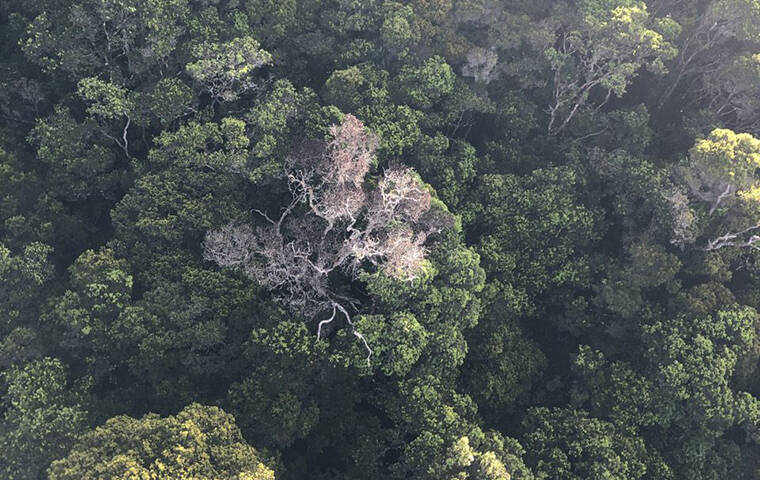Rapid ohia death found in northwest Kauai

COURTESY DLNR
Rapid ohia death has been confirmed in a dead tree at Alakai Plateau in northeast Kauai.
State officials have confirmed the presence of rapid ohia death Opens in a new tab in a pristine wilderness area of northwest Kauai.
The fungal pathogen was detected and confirmed by a lab test in a dead ohia lehua tree in a forest known as Alakai Plateau. Over the past four years, some 60 trees in the area have been tested due to reddish-brown leaves, which are symptoms of the disease, but none had tested positive until this one.
“We’ve been preparing for this day, sad as it is,” said Mapuana O’Sullivan, state Division of Forestry and Wildlife Kauai Forest Management Supervisor, in a news release.
O’Sullivan said the dead tree was spotted during regular helicopter surveys late last year. Surveyors immediately returned to the area by foot to collect wood chip samples that could be tested for the disease. The Agricultural Research Service in Hilo confirmed, upon testing, that the tree died of Ceratocystis lukuohia, the more virulent of two fungal pathogens known to cause rapid ohia death.
Up to December of last year, 175 ohia trees on Kauai have tested positive for C. lukuohia, while 114 have tested positive for the less virulent pathogen, C. huliohia. Three trees have tested positive for both.
The area where the infected tree was found, at an elevation of 4,100 feet, is known as one of the most biodiverse areas on the island.
Don't miss out on what's happening!
Stay in touch with breaking news, as it happens, conveniently in your email inbox. It's FREE!
Ohia lehua, or Metrosideros polymorpha, are the most abundant native tree in Hawaii, critical to providing watershed protection and food and shelter for native birds. Since rapid ohia death was first identified on Hawaii island in 2014, more than a million trees have died on various isles due to the blight.
Officials said they decided not to cut down the infected tree in an effort to avoid damaging healthy ohia nearby.
Instead, the response team on Kauai is applying an environmentally-friendly beetle repellent to the infected tree’s bark to help keep ambrosia beetles away. The beetles produce a wood powder that can include live Ceratocystis spores when tunneling into trees, officials said, which is how the fungus is released into the environment.
The team, which is made up of state and federal agencies and non-governmental organizations, will continue to sample ohia in the Kokee area and around Kauai.




